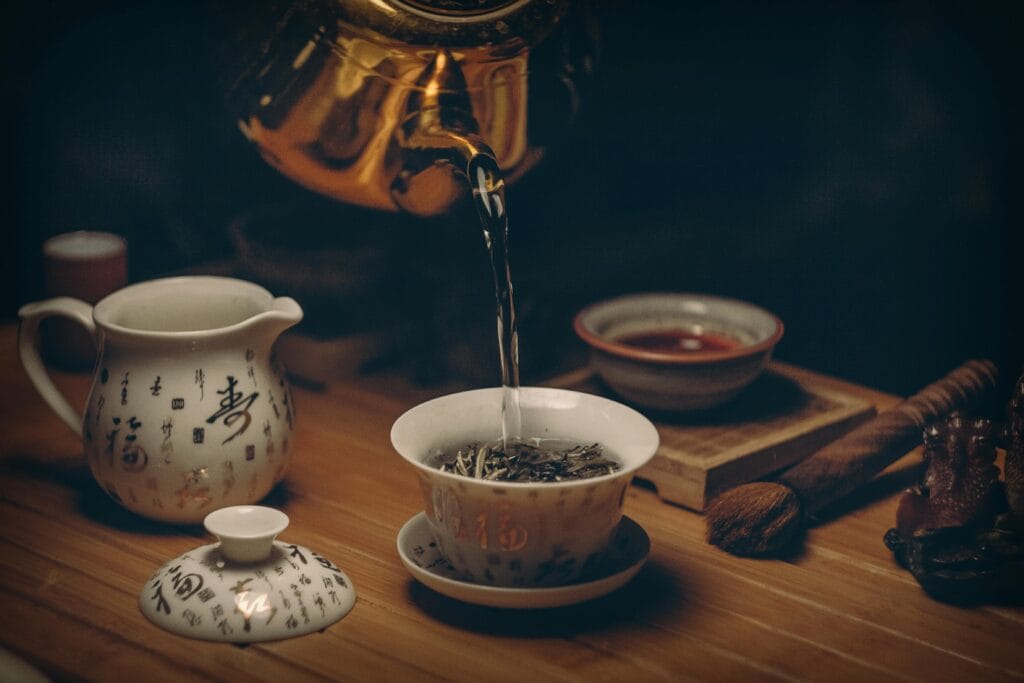Health Benefits of Pu’er Tea
A joint study by four research institutions and hospitals, including the French National Institute of Health and Medical Research, has provided detailed reports on the health benefits of Pu’er tea. Through repeated experiments and clinical trials, they found strong scientific evidence supporting its effects in lowering blood lipids, reducing uric acid, regulating cholesterol, promoting sobriety, aiding weight loss, enhancing metabolism, and acting as an antioxidant and free radical scavenger. In clinical trials, Pu’er tea showed impressive results.
Professor Sun Lushi of Taiwan University discovered that Pu’er tea inhibits cholesterol synthesis in the liver by up to 41%, increases gastrointestinal motility, reduces fat absorption, and accelerates fat excretion, with a fat excretion rate of up to 66% in feces. In a comparison study at the First Affiliated Hospital of Kunming Medical University, Pu’er tea was found to be more effective than the commonly used lipid-lowering drug Atorvastatin, with no side effects. These findings and clinical results have gradually revealed the remarkable effects of Pu’er tea and its ancient, mysterious qualities.

Pu’er tea absorbs the essence of the earth and sky from the primeval forests of the Yunnan mountains. It thrives in the humid, misty environment and travels across various regions, reaching Sichuan, Hubei, Jiangnan, Fujian, and eventually the world. The allure of Pu’er tea is vast, and as people gain deeper insights, its diverse qualities are becoming more apparent. Every phenomenon and its effects have a material foundation. Famous scientist Darwin concluded that the survival of species is not due to their strongest vitality but their ability to adapt to their environment. Similarly, in Chinese philosophy, it is said, “Survival of the fittest.” Pu’er tea is a prime example, showcasing its unique characteristics derived from its environment.
Provinca Yunnan, located between 21°8′32″–29°15′8″N and 97°31′39″–106°11′47″E, is a high-altitude region in southwestern China with a tropical and subtropical climate influenced by the Pacific and Indian Ocean monsoons. The region has significant topographical variation, with mountain ranges covering 93% of the area, creating unique climate conditions. These conditions, along with the prominent seasonal differentiation between wet and dry periods, provide an ideal environment for tea cultivation.
The main Pu’er tea production areas, such as Xishuangbanna, Pu’er, Lincang, Dali, and Baoshan, have soil that is rich in trace elements like nitrogen, potassium, and phosphorus—essential for plant growth. These elements dissolve in the water and acidic environment, becoming vital nutrients for the tea plants. The soil is particularly favorable for tea tree growth, especially under the canopy of tropical and subtropical forests. Pu’er tea thrives in a delicate balance of light, temperature, and moisture, resulting in tea leaves with rich polyphenols and other beneficial compounds.
The large-leaf variety of tea in Yunnan is unique due to the region’s geographical and climatic conditions. In other regions, the tea leaves would become smaller, and the nutritional content would decrease significantly. This uniqueness is the basis for the global recognition of Yunnan’s large-leaf tea as a special and irreplaceable variety.

Yunnan is the genetic treasure trove of tea plants in China, with a diverse range of tea species. Fossils found in the region confirm that Yunnan is the birthplace of tea, making it the center of the world’s tea plant resources. The high-quality large-leaf tea trees, which grow vigorously in the region’s mountains, produce leaves with abundant nutrients such as polyphenols, amino acids, and catechins, setting the foundation for the exceptional quality of Pu’er tea.
Pu’er tea’s exceptional qualities are further enhanced during the post-harvest processing and aging process. The unique methods of sun-drying, pile-fermentation, and aging lead to the formation of new compounds that contribute to the tea’s health benefits. These compounds, combined with the traditional and scientific tea processing techniques, ensure that Pu’er tea will continue to enjoy a bright future. The raw materials of Pu’er tea, with their rich organic content and distinct flavors, undergo a transformation during processing that shifts from fresh, intense flavors to a smooth, mellow taste with a lasting fragrance.
Numerous countries and medical research institutions have shown interest in studying Pu’er tea. Renowned American medical expert Professor Joseph has praised tea as one of the five greatest contributions to the world after China’s Four Great Inventions, highlighting its global significance.A joint study by four research institutions and hospitals, including the French National Institute of Health and Medical Research, has provided detailed reports on the health benefits of Pu’er tea. Through repeated experiments and clinical trials, they found strong scientific evidence supporting its effects in lowering blood lipids, reducing uric acid, regulating cholesterol, promoting sobriety, aiding weight loss, enhancing metabolism, and acting as an antioxidant and free radical scavenger.
In clinical trials, Pu’er tea showed impressive results. Professor Sun Lushi of Taiwan University discovered that Pu’er tea inhibits cholesterol synthesis in the liver by up to 41%, increases gastrointestinal motility, reduces fat absorption, and accelerates fat excretion, with a fat excretion rate of up to 66% in feces. In a comparison study at the First Affiliated Hospital of Kunming Medical University, Pu’er tea was found to be more effective than the commonly used lipid-lowering drug Atorvastatin, with no side effects. These findings and clinical results have gradually revealed the remarkable effects of Pu’er tea and its ancient, mysterious qualities.
Pu’er tea absorbs the essence of the earth and sky from the primeval forests of the Yunnan mountains. It thrives in the humid, misty environment and travels across various regions, reaching Sichuan, Hubei, Jiangnan, Fujian, and eventually the world. The allure of Pu’er tea is vast, and as people gain deeper insights, its diverse qualities are becoming more apparent. Every phenomenon and its effects have a material foundation. Famous scientist Darwin concluded that the survival of species is not due to their strongest vitality but their ability to adapt to their environment. Similarly, in Chinese philosophy, it is said, “Survival of the fittest.” Pu’er tea is a prime example, showcasing its unique characteristics derived from its environment.
Provinca Yunnan, located between 21°8′32″–29°15′8″N and 97°31′39″–106°11′47″E, is a high-altitude region in southwestern China with a tropical and subtropical climate influenced by the Pacific and Indian Ocean monsoons. The region has significant topographical variation, with mountain ranges covering 93% of the area, creating unique climate conditions. These conditions, along with the prominent seasonal differentiation between wet and dry periods, provide an ideal environment for tea cultivation.

The main Pu’er tea production areas, such as Xishuangbanna, Pu’er, Lincang, Dali, and Baoshan, have soil that is rich in trace elements like nitrogen, potassium, and phosphorus—essential for plant growth. These elements dissolve in the water and acidic environment, becoming vital nutrients for the tea plants. The soil is particularly favorable for tea tree growth, especially under the canopy of tropical and subtropical forests. Pu’er tea thrives in a delicate balance of light, temperature, and moisture, resulting in tea leaves with rich polyphenols and other beneficial compounds.
The large-leaf variety of tea in Yunnan is unique due to the region’s geographical and climatic conditions. In other regions, the tea leaves would become smaller, and the nutritional content would decrease significantly. This uniqueness is the basis for the global recognition of Yunnan’s large-leaf tea as a special and irreplaceable variety.
Yunnan is the genetic treasure trove of tea plants in China, with a diverse range of tea species. Fossils found in the region confirm that Yunnan is the birthplace of tea, making it the center of the world’s tea plant resources. The high-quality large-leaf tea trees, which grow vigorously in the region’s mountains, produce leaves with abundant nutrients such as polyphenols, amino acids, and catechins, setting the foundation for the exceptional quality of Pu’er tea.
Pu’er tea’s exceptional qualities are further enhanced during the post-harvest processing and aging process. The unique methods of sun-drying, pile-fermentation, and aging lead to the formation of new compounds that contribute to the tea’s health benefits. These compounds, combined with the traditional and scientific tea processing techniques, ensure that Pu’er tea will continue to enjoy a bright future. The raw materials of Pu’er tea, with their rich organic content and distinct flavors, undergo a transformation during processing that shifts from fresh, intense flavors to a smooth, mellow taste with a lasting fragrance.
Numerous countries and medical research institutions have shown interest in studying Pu’er tea. Renowned American medical expert Professor Joseph has praised tea as one of the five greatest contributions to the world after China’s Four Great Inventions, highlighting its global significance.